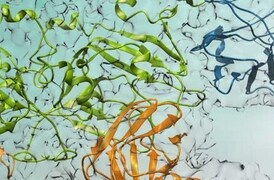Search Thermo Fisher Scientific
Direct electron detector camera for cryo-EM
The Thermo Scientific Falcon 4i Direct Electron Detector is the ideal solution for your single particle analysis and cryo-tomography applications. With its unique combination of high image quality, high throughput, efficient lossless data compression enabled via electron-event representation (EER), and a streamlined solution for data management and quality monitoring, the Falcon 4i Detector offers a productivity and performance boost that meets the demands of today’s scientific and industrial communities.
The Falcon 4i Detector is fully integrated in Thermo Scientific EPU and Tomography Software, allowing for smooth daily instrument operation and data acquisition. The camera’s output is recorded through the Data Management Platform (DMP), which also facilitates the organization, viewing, and sharing of single particle cryo-EM data. You can easily view all the project data and metadata at the microscope or remotely through a secure connection, and can comment and share it with collaborators.
Note: The Falcon 4i Direct Electron Detector is fully compatible with 200 and 300 kV Thermo Scientific Krios, Glacios, and Talos Cryo-Transmission Electron Microscopes (Cryo-TEMs) operating with Windows 10. A Falcon 4i Upgrade Kit is available for the Falcon 4 Direct Electron Detector. The Falcon 4i Upgrade Kit upgrade is also applicable for the Thermo Scientific Selectris and Selectris X Imaging Filters.

Selectris and Selectris X Imaging Filters
Designed for stability and speed, the Thermo Scientific Selectris and Selectris X Imaging Filters are post-column imaging filters that improve the contrast of TEM images, resulting in high-resolution structures up to atomic resolution. Paired with the latest generation Thermo Scientific Falcon 4i Direct Electron Detector, Selectris Filters enable you to obtain high-resolution structures quickly, revealing new biological insights. To further increase the productivity and ease-of-use of your cryo-electron microscopy (cryo-EM) research, these filters are fully integrated into Thermo Scientific EPU Software, Thermo Scientific Tomography Software, and instrument operation software. The Selectris and Selectris X Imaging Filters are available on Thermo Scientific Krios and Glacios Cryo-TEMs.
The Falcon 4i Direct Electron Detector enables high resolution and throughput.

Apoferritin reconstruction at 1.2 Å resolution created from 3,600 images of 297k particles acquired in 6 hours (EPU data acquisition on the Thermo Scientific Krios G4 Cryo-TEM). Recorded at a dose rate of 5.4 e/p/s.

Amyloid-β 42 filaments isolated from human brain resulting in a 2.5 Å resolution reconstruction. Data collected at dose rate 8 e/p/s, 40 e/A2 total dose and 570 movies/hr. Collaboration with MRC Laboratory of Molecular Biology. doi: https://doi.org/10.1101/2021.10.19.464936
Unsurpassed image quality through higher DQE
Get leading detective quantum efficiency (DQE) across the full spatial frequency range. High DQE at low spatial frequency lets you visualize and align smaller and more flexible proteins, while high DQE at high spatial frequencies lets you achieve results with fewer images or increased resolution.

Large pixels with high signal-to-noise ratio (SNR)
The large signal generated by the Falcon 4i Detector’s large pixels, combined with low noise, yields high SNR – electron events can be unambiguously separated from the background noise (left) in comparison to detectors with smaller pixels (right).

Higher throughput for more images per hour
The increased internal frame rate, in combination with improved overhead, yields a significant increase in throughput, depending on the use case.

Lossless data compression with electron-event representation (EER)
Electron-event representation (EER) data enables efficient cryo-EM file storage with full preservation of spatial and temporal resolution. Counted events of all raw frames are available for processing with full temporal resolution (320 fps) and spatial resolution (events are localized to one-sixteenth of a pixel). This super resolution capability maximizes the benefit of the Falcon 4i Detector’s superior DQE at high spatial frequencies.

| Camera architecture | Direct electron detection | |
| Sensor size | 4,096 × 4,096 pixels, ~ 5.7 x 5.7 cm2 | |
| Pixel size | 14 x 14 μm2 | |
| TEM Operating voltage | 200 kV, 300 kV | |
| Internal frame rate | 320 fps | |
| Frame rate to storage | 320 fps (EER mode) | |
| Camera Overhead time | 0.5 s per acquisition | |
| File formats | EER (native), MRC, TIFF, LZW TIFF | |
| Lifetime (<10% DQE degradation) | 5 years in normal use (1.5Ge/px) | |
| Detection Modes | Electron counting mode Survey mode (fast linear mode) | |
| Imaging performance in EER mode (4k x 4k) | 300 kV | 200 kV |
| DQE (0) | 0.92 | 0.91 |
| DQE (½ Nq) | 0.72 | 0.62 |
| DQE (1 Nq) | 0.50 | 0.33 |
To find out more, contact us today by filling out the form below.

Falcon 4i in 4 minutes

Falcon 4i in 4 minutes

感染症研究
クライオ電子顕微鏡技術により、さまざまなスケールの3D生体構造が自然に近い状態で観察できるようになり、より迅速かつ効率的な医薬品開発を促進しています。

創薬
多くの主要な医薬品候補群について合理的薬物設計を行い、最高レベルの医薬品を開発する方法をご覧ください。

単粒子解析法
単粒子解析法(SPA)はクライオ電子顕微鏡法のひとつであり、原子分解能に近い構造解析が可能で、ダイナミックな生物学的プロセスおよび生体分子複合体/アセンブリの構造を明らかにします。

クライオトモグラフィー
クライオ電子線トモグラフィー(cryo-ET)を用いれば、個々のタンパク質の構造情報と細胞内の空間的な位置関係の両方を明らかにできます。これはcryo-ET特有の機能であり、この機能により、cryo-ETは細胞生物学における大きな可能性を秘めています。Cryo-ETは光学顕微鏡法と、単粒子解析法などの原子レベルに近い分解能を達成する手法とを橋渡しする技術です。

統合構造生物学
タンパク質の機能を理解するためには、個々のタンパク質だけではなく、タンパク質複合体の構造情報も理解することが必要です。統合構造生物学では、質量分析法とクライオ電子顕微鏡法を組み合わせ、大規模なタンパク質複合体の動的構造を把握できます。

単粒子解析法
単粒子解析法(SPA)はクライオ電子顕微鏡法のひとつであり、原子分解能に近い構造解析が可能で、ダイナミックな生物学的プロセスおよび生体分子複合体/アセンブリの構造を明らかにします。

クライオトモグラフィー
クライオ電子線トモグラフィー(cryo-ET)を用いれば、個々のタンパク質の構造情報と細胞内の空間的な位置関係の両方を明らかにできます。これはcryo-ET特有の機能であり、この機能により、cryo-ETは細胞生物学における大きな可能性を秘めています。Cryo-ETは光学顕微鏡法と、単粒子解析法などの原子レベルに近い分解能を達成する手法とを橋渡しする技術です。

統合構造生物学
タンパク質の機能を理解するためには、個々のタンパク質だけではなく、タンパク質複合体の構造情報も理解することが必要です。統合構造生物学では、質量分析法とクライオ電子顕微鏡法を組み合わせ、大規模なタンパク質複合体の動的構造を把握できます。
Related Products
ライフサイエンス向けの
電子顕微鏡サービス
最適なシステム性能をお届けするため、当社は国際的なネットワークで、分野ごとのサービスエキスパート、テクニカルサポート、正規交換部品などを提供しています。









